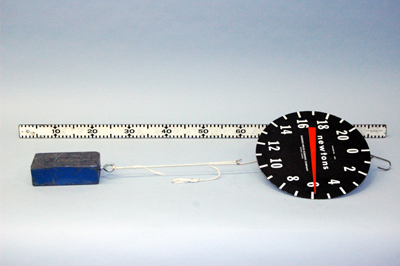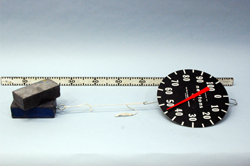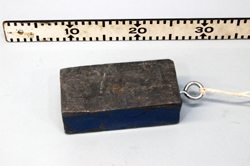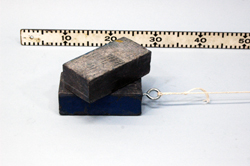|
Size: 3501
Comment: converted to 1.6 markup
|
← Revision 15 as of 2018-07-18 16:58:33 ⇥
Size: 3685
Comment:
|
| Deletions are marked like this. | Additions are marked like this. |
| Line 2: | Line 2: |
| ||<:30%>[[PiraScheme#Mechanics| Table of Mechanics Demonstration]]||<:30%>[[MEEquipmentList| List of Mechanics Equipment & Supplies]]||<:30%>[[Demonstrations|Lecture Demonstrations]]|| | ||<30% style="text-align:center">[[PiraScheme#Mechanics|Table of Mechanics Demonstration]] ||<30% style="text-align:center">[[MEEquipmentList|List of Mechanics Equipment & Supplies]] ||<30% style="text-align:center">[[Demonstrations|Lecture Demonstrations]] || |
| Line 5: | Line 6: |
| '''Topic and Concept:''' | |
| Line 6: | Line 8: |
| '''Topic and Concept:''' Applications of Newton's Laws, [[AppNewtonsLaws#Friction| 1K20. Friction]] |
. Applications of Newton's Laws, [[AppNewtonsLaws#Friction|1K20. Friction]] '''pira200 Listed''' |
| Line 10: | Line 13: |
| Line 13: | Line 17: |
| Line 19: | Line 22: |
||<:style="width: 60%" :40%>'''Equipment'''||<:30%>'''Location'''||<:25%>'''ID Number'''|| |
||<40% style="" ;text-align:center">'''Equipment''' ||<30% style="text-align:center">'''Location''' ||<25% style="text-align:center">'''ID Number''' || |
| Line 22: | Line 24: |
| ||Scale||ME, Bay B2, Shelf #1|| || ||Lead Block w/Attached String||ME, Bay B5, Shelf #2|| || |
||Scale ||ME, Bay B2, Shelf #1 || || ||Lead Block w/Attached String ||ME, Bay B5, Shelf #2 || || |
| Line 27: | Line 29: |
| '''''Important Setup Notes:''''' * N/A |
|
| Line 30: | Line 30: |
| '''''Important Setup Notes:''''' | |
| Line 31: | Line 32: |
| '''Setup and Procedure:''' | * N/A '''Setup and Procedure:''' |
| Line 43: | Line 46: |
| '''Discussion:''' | '''Discussion:''' |
| Line 46: | Line 49: |
| || {{attachment:Setup01-250.jpg}} || {{attachment:LeadBrick01-250.jpg}} || {{attachment:LeadBrick02-250.jpg}} || {{attachment:SpringScale08-250.jpg}} || | |
| Line 48: | Line 52: |
| ||{{attachment:Setup01-250.jpg}}||{{attachment:LeadBrick01-250.jpg}}||{{attachment:LeadBrick02-250.jpg}}||{{attachment:SpringScale08-250.jpg}}|| | |
| Line 51: | Line 55: |
| Line 57: | Line 62: |
Static vs. Kinetic Friction, 1K20.30
Topic and Concept:
Applications of Newton's Laws, 1K20. Friction
pira200 Listed
Location:
Cabinet: Mechanic (ME)
Bay: (B5)
Shelf: #2

Abstract:
A spring scale attached to a block is used to pull on the block until it begins to move. The force registering on the scale is largest just before the block begins to move demonstrating that static friction is greater than kinetic friction.
Equipment |
Location |
ID Number |
|
|
|
Scale |
ME, Bay B2, Shelf #1 |
|
Lead Block w/Attached String |
ME, Bay B5, Shelf #2 |
|
Important Setup Notes:
- N/A
Setup and Procedure:
- Place the lead block on the lecture table or the Floor. The tables are quite smooth and have a low surface friction so two lead blocks maybe needed.
- Attach the scale to the block using the attached hook and the string attached to the block.
- Slowly and steadily pull the scale away from the block, and note the force that is registering just before the block begins to move.
- Maintaining the same pulling force, note the new amount of force registering on the scale.
- Noting the difference between the two forces, one can roughly determine the ratio of the two different coefficients of friction for the block used.
Cautions, Warnings, or Safety Concerns:
Wash hands after handling the lead block as lead dust is toxic. It enters the body through ingestion not through the skin.
Discussion:
Friction arises from topological imperfections of the two surfaces in contact; the rougher the surface, the harder it is to slide it across another surface. Fundamentally, it is thought to arise from Coulomb forces between the atoms in the material and their relative positions. It acts to oppose motion. The magnitude of static friction is Ffr ≤ μs*Fn = μs * m * g where μs is the coefficient of static friction, m is the mass of the block, and g is the acceleration due to gravity. The net force on the block along the table top is the tension (equal to the counterweight treating the pulley as frictionless and massless) minus the frictional force: Fnet = T - Ffr = 0 until the block begins to move. Thus, the force registering on the scale is exactly the magnitude of the force of static friction. If T > Ffr, the block will move. The net force on the moving block is the tension minus the force due to kinetic friction: T - Ffr = T - μk * Fn = μk * m * g, where μk is the coefficient of kinetic friction. It is always the case that μs > μk .
|
|
|
|
Videos:
References:



